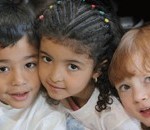Cultural Diversity in Our Classrooms
by Grace Pires, Junior High School Student & volunteer at Promise the Children & Girl’s Inc.
There’s no denying that America is a multicultural melting pot. So it’s only fair that the American education system  openly acknowledges various white and non-white cultures and promotes diversity in the classroom. By teaching students about other cultures, starting in pre school and continuing in grade school, teachers can enable young children to respect others whose traditions and appearances are different from their own.
openly acknowledges various white and non-white cultures and promotes diversity in the classroom. By teaching students about other cultures, starting in pre school and continuing in grade school, teachers can enable young children to respect others whose traditions and appearances are different from their own.
Children already begin to distinguish gendered and racial differences in their peers by the age of two . Utilizing fun classroom activities to promote positive perceptions of people who are different could help our youngest children avoid being prejudiced against others for their differences as they grow older.
Not only is a multicultural perspective important to teach the white American children respect, it also helps children of color. The encouraging attitudes about being ethnically different helps “develop a positive self-concept in those children who are most affected by racism,” and promotes acceptance of their own differences.
Teaching children about other cultures — regardless of the classroom’s composition– is important as well (and sho uld begin in preschool). It’s necessary to encourage an interest in all cultures, not just specifically white-centric ones. Representation, whether in the classroom or in mainstream media, is also crucial to a child’s self esteem. When discussing important historical figures, it can be difficult for a child to picture themselves as a heroic icon if the person has no similarities that the child can relate to. This is also true about heroes and heroines in books read aloud or available in the school library. Some of those books should should appeal to children of different cultures. A child will enjoy reading more if the cultural content is sometimes familiar. Representation is important to a child’s self confidence and their acceptance of others.
uld begin in preschool). It’s necessary to encourage an interest in all cultures, not just specifically white-centric ones. Representation, whether in the classroom or in mainstream media, is also crucial to a child’s self esteem. When discussing important historical figures, it can be difficult for a child to picture themselves as a heroic icon if the person has no similarities that the child can relate to. This is also true about heroes and heroines in books read aloud or available in the school library. Some of those books should should appeal to children of different cultures. A child will enjoy reading more if the cultural content is sometimes familiar. Representation is important to a child’s self confidence and their acceptance of others.
Visit Promise the Children for more information and sign up for our timely action alerts in support of important issues. Communicating with you via our web site and social media costs a bit of money! We appreciate your donations. We are mostly dedicated volunteers who work to keep you informed about the needs of our nation’s young children. Like us on Facebook and follow us on Twitter! Thanks!


I definitely think it’s important that children learn about other cultures. It opens their minds and helps them realize that there’s more than one “right” “normal” lifestyle. I think it is also important, however, that we not condone dangerous/harmful aspects of a culture. It can be hard for a teacher to balance respect for other cultures and discussion of unethical practices those cultures might engage in. But, those discussions should probably be saved for older children. Young children need both to learn about other cultures and to see positive representations of their own cultures. This can also be a difficult balance to maintain, but it is a vital one.
We must learn about diverse cultures while feeling at home in our own.